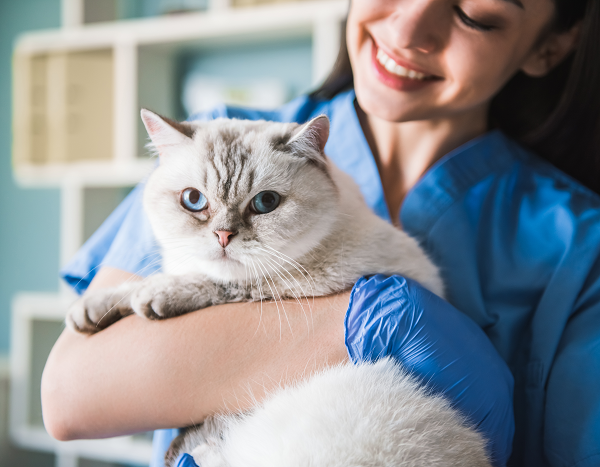
Recent studies have shown that more than half the cats in the US have not been seen by a veterinarian within the past year for a wellness visit! And 50% of cat owners feel that a visit to the veterinarian is too stressful for their pet, versus only 20% for dog owners.
Many cats only see their vet when they are sick. But the fact is, regular wellness exams are an important part of cat ownership.
Since our pets can’t tell us when they’re sick, we need to be attentive to their routine health care. This is especially important for cats, who many don’t realize are actually considered prey species (since they are also good predators). Prey species have evolved to be masters of hiding signs of illness in order to stay alive!
Also, cats age way more quickly than humans, so an annual check-up for your cat is like you going to the doctor about every four years. During these appointments, your veterinarian will perform a routine physical exam and ask questions about your pet’s daily life at home that can uncover early signs of illness or disease.
Below are some reasons why it’s so important to take your cat to the vet:
- Cats are masters of hiding illness. As a part of their instinct to protect themselves from predators, cats hide that they are ill, in pain, or in a weakened state. Your cat could be developing a health condition and you may not notice anything wrong until the condition has advanced and is more difficult to treat.
- An ounce of prevention is worth a pound of cure. Veterinarians are trained to spot problems early. Taking your cat for regular wellness checks allows your veterinarian to see subtle changes and abnormalities that can easily be overlooked. Spotting and treating problems early, before they are complex and difficult to treat, can translate into better outcomes for your cat – and tends to be less costly.
- Obesity is . More than 50% of cats in North America are overweight or obese. Many health conditions are linked to obesity, such as osteoarthritis, joint damage, diabetes, heart disease, and cancer. At a regular wellness exam, your veterinarian checks your cat’s weight and provides you with guidance on achieving or maintaining their ideal weight. One or two pounds may not seem like much, but on a 10-pound cat, 2 pounds is 20% of their body weight!
- Aging happens quickly. Cats age more quickly than humans. A one-year-old cat is equivalent to a 15-year-old human; a two-year-old cat is close to 24 in human years! Each year thereafter is about 4 human years. A lot can happen or change in those years, which is why annual or biannual veterinary visits are so important.
- Dental disease can be prevented. Your adult cat has 30 teeth, which is a lot of teeth to maintain. More than 50% of cats over age three have some form of dental disease; but again, cats will hide pain caused by dental disease. Your veterinarian will check your cat’s teeth, provide advice for maintaining a healthy mouth, and recommend professional cleaning if needed. Dental health can affect overall health, so it’s an important part of overall wellness care.
How often your cat should see the vet for wellness checks depends on their health status. veterinarian will recommend an appointment schedule with your cat’s best interests in mind.
Getting your cat to your veterinarian may seem challenging, but taking some steps ahead of time will help make this easier for both you and your cat.
- Make the carrier a fun place. Train your cat to like her carrier by making it tempting! Place the carrier in your living room or other common area, put her favorite toys, blanket, and treats in the carrier, and keep it there for a while, so she becomes accustomed to it. You can even feed your cat in her carrier, so she associates it with pleasant events. Choose a carrier with a removable lid: once at the clinic, you can remove the lid and gently lift your cat out, rather than forcibly pulling her. Your veterinarian may even be able to perform part of the exam while your cat is still comfortably in her crate! Always use a seatbelt to restrain the carrier in your car.
- Plan your visit with the clinic. Many veterinary clinics have procedures to help keep cats more comfortable during veterinary visits. Check with your clinic to see how your veterinary team can help make the visit as smooth as possible and if there are any steps you can take at home before the visit.
No one really likes going to the doctor, but regular wellness checks can help prevent illnesses, detect early signs of disease, and keep your cat a healthy member of your family for a long time. This August 22, make an appointment to take your cat to the vet!
